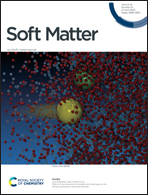Clustering and phase separation in mixtures of dipolar and active particles
Abstract
The self-assembly of colloidal particles in dynamic environments has become an important field of study because of potential applications in fabricating out-of-equilibrium materials. We investigate the phase behavior of mixtures of passive dipolar colloids and active soft spheres using Brownian dynamics simulations in two dimensions. The phase behaviors exhibited include dipolar percolated network, dipolar string-fluid, isotropic fluid, and a phase-separated state. We find that the clustering of dipolar colloids is enhanced in the presence of slow-moving active particles compared to the clustering of dipolar particles mixed with passive particles. When the active particle motility is high, the chains of dipolar particles are either broken into short chains or pushed into dense clusters. Motility-induced phase separation into dense and dilute phases is also present. The area fraction of particles in the dilute phase increases as the fraction of active particles in the system decreases, while the area fraction of particles in the dense phase remains constant. Our findings are relevant to the development of reconfigurable self-assembled materials.



 Please wait while we load your content...
Please wait while we load your content...